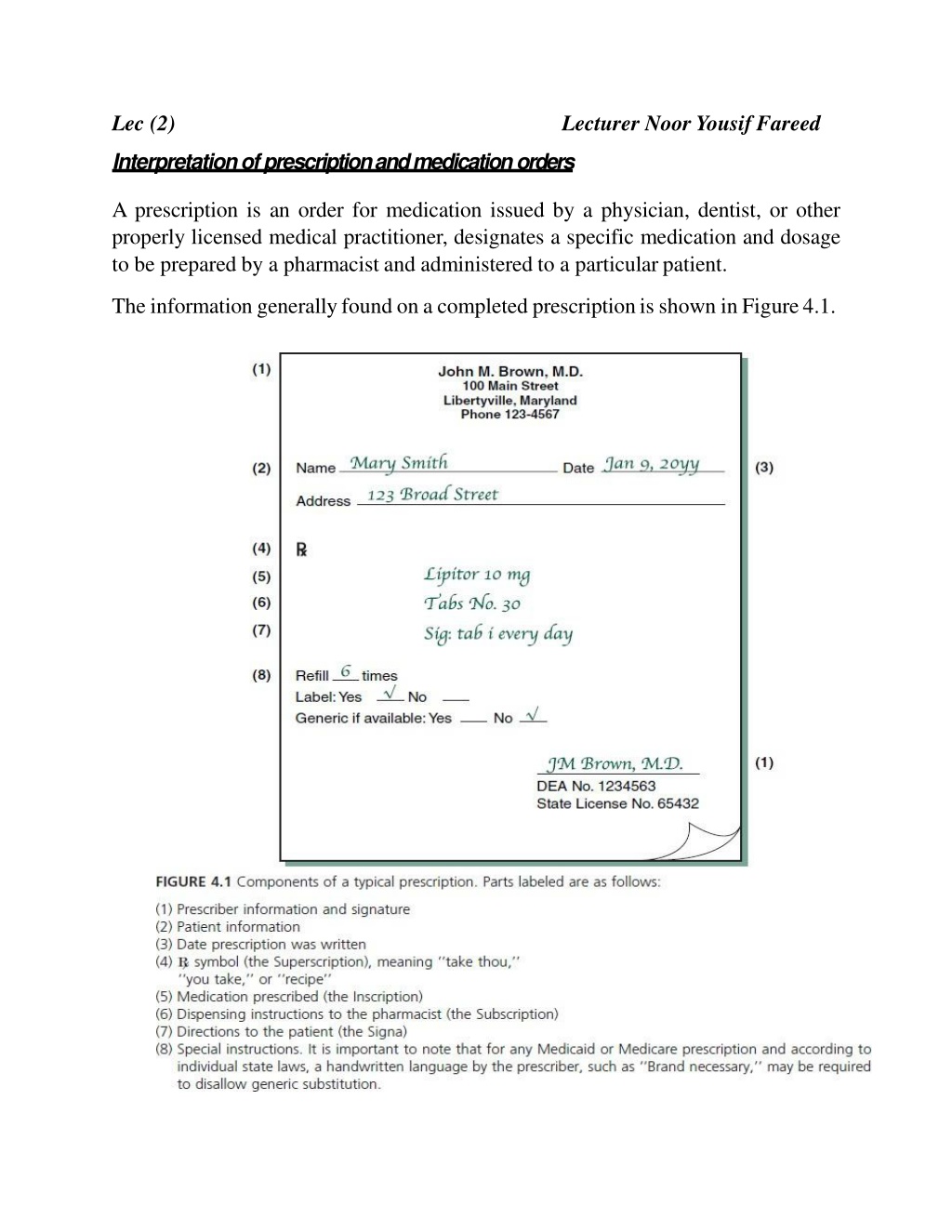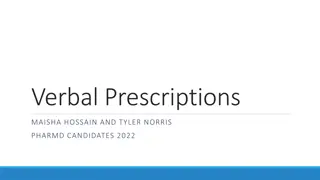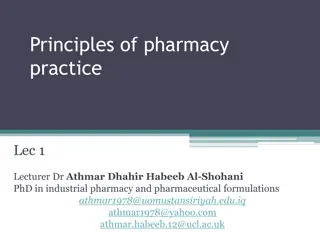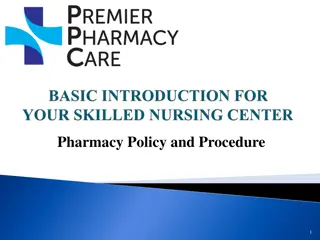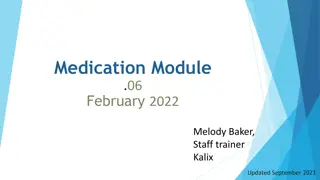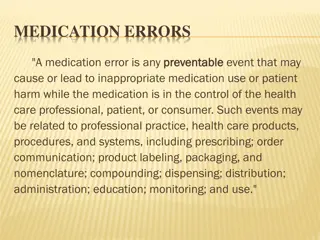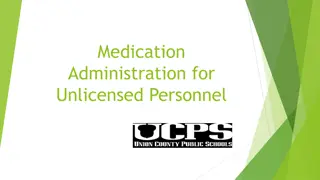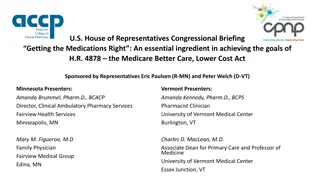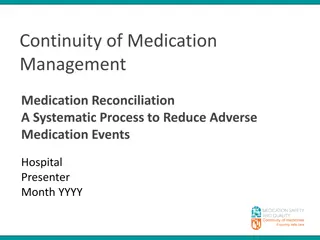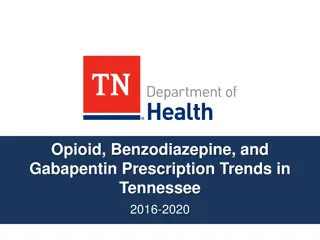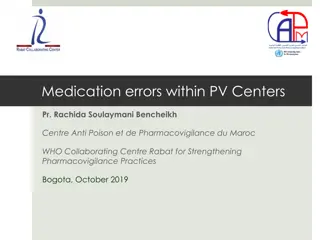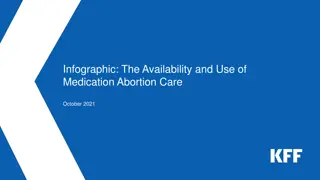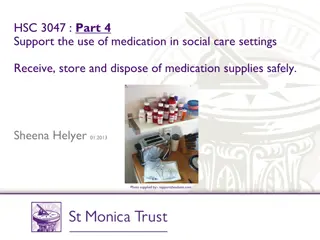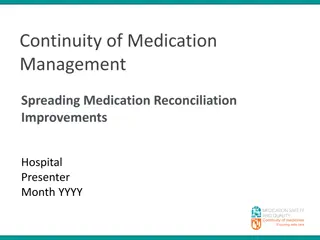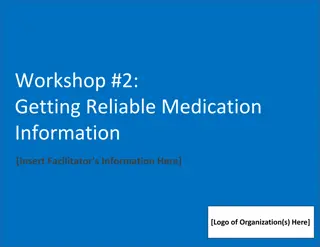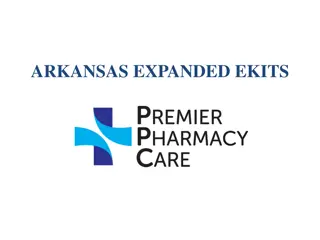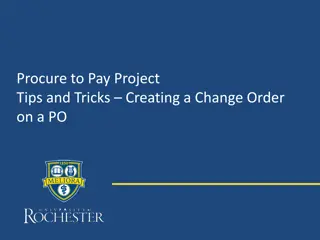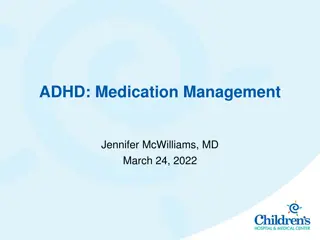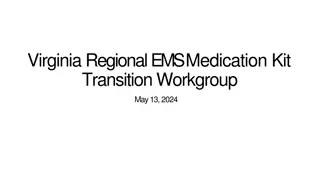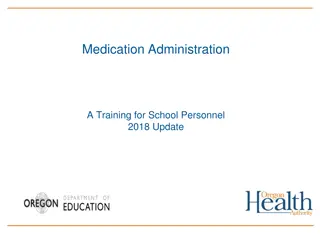Understanding Medication Orders and Prescriptions
A prescription is a crucial order for medication issued by medical practitioners, specifying medication details for a specific patient. This includes dosage, patient information, and may require compounding by pharmacists. Different types of prescriptions exist, such as those for single-component products or compounding. E-prescribing is becoming more common, enhancing accuracy and efficiency in medication orders. Roman numerals are used to indicate quantities in prescriptions to ensure precise dosing.
Download Presentation

Please find below an Image/Link to download the presentation.
The content on the website is provided AS IS for your information and personal use only. It may not be sold, licensed, or shared on other websites without obtaining consent from the author. Download presentation by click this link. If you encounter any issues during the download, it is possible that the publisher has removed the file from their server.
E N D
Presentation Transcript
Lec (2) Lecturer Noor Yousif Fareed Interpretation of prescription and medicationorders A prescription is an order for medication issued by a physician, dentist, or other properly licensed medical practitioner, designates a specific medication and dosage to be prepared by a pharmacist and administered to a particularpatient. Theinformation generallyfoundon a completed prescriptionis shown in Figure4.1.
In hospitals andotherinstitutions, theforms are somewhat different andare referred to as medication orders. A typical medication order sheet is shown in Figure4.2. Aprescription ormedicationorderfor an infant,child,or an elderlyperson may also include age, weight, and/or body surface area (BSA) of the patient.
An example of a prescription written for a pediatric patient is shown in Figure 4.3. This information is sometimes necessary in calculating the appropriate medication dosage. It is important to recognize two broad categories of prescriptions: (1)Those written for a singlecomponent or prefabricated product and not requiring compounding or admixture by the pharmacist, (2) Those written for more than a single component and requiring compounding. A prescription may include the chemical or nonproprietary (generic) name of the substance or the manufacturer s brand or trademark name.
Examples are shown for prescriptions calling for trade-name products (Fig. 4.1 and Fig. 4.3), a generic drug (Fig. 4.4), and compounding (Fig. 4.5).
E- prescribing/ e- prescriptions: A medication order, for a patient is entered into an automated data entry system as a personal computer (PC) or a handheld device loaded with e-prescribing software and sent to a pharmacy as an e-prescription. When received, a pharmacist immediately reduces the order to a hard copy and/or stores it as a computer file. Prescription and medication order accuracy It is the responsibility of the pharmacist to ensure that each prescription and medication order given in correct form, each medication should be: therapeutically appropriate for the patient; prescribed at the correct dose; dispensed in the correct strength and dosage form; correctly labeled with complete instructions for the patient or caregiver; and for the patient in a hospital or other health care facility, each medication must be administered to the correct patient, at the correct time, and by the correct rate and route of administration. Use of Roman numerals on prescriptions Roman numerals commonly are used in prescription writing to designate quantities, as the: (1) quantity of medication to be dispensed and/or (2) quantity of medication to be taken by the patient per dose.
The following rules apply in the use of Roman numerals: 1. A letter repeated once or more, repeats its value (e.g., xx = 20; xxx = 30). 2.One or more letters placed after a letter of greater value increases the value of the greater letter (e.g., vi = 6; xij = 12; lx = 60). 3.A letter placed before a letter of greater value decreases the value of the greater letter (e.g., iv= 4; xl = 40). Capital or lower case letters may be used. A j may be used as the final i in a sequence (e.g., viij). Use of abbreviation and symbols The use of abbreviations is common on prescriptions and medication orders. Some are derived from the Latin through its historical use in medicine and pharmacy, whereas others have evolved through prescribers use of writing shortcuts. A list of some of these abbreviations is presented in Table 4.2.
TABLE 4.2 SELECTED ABBREVIATIONS , ACRONYM S, AND SYMBOLS USED IN PRESCRIPTIONS AND MEDICATION ORDERsa,b ABBREVIATlON (LATIN ORIGIN') Prescriptio n Filling Directions aa. or (ana) ad (ad) disp. (dispensatur) div. (dividatur) d.t.d. (dentur tales doses) ft (fiat) M. (mice) No. (numero) non rep. or NR (non repatatur) q.s. (quantum suff icit) q.s. ad (quantum suff iciat ad) Sig. (Signa) ABBREVIATION (LATIN ORIGIN') pt. qt. ss or ss(semissem tbsp. tsp. Signa/Patient Instruct ions a.c. (ante cibos) adlib. (adlibitum) admin A.M. (ante meridiem) aq.(aqua) ATC b.i.d. (bis in die) c or e (cum) d (die) d il. (dilutus) et h. or hr. (hora) h.s. (hora somni) i.e. (intercibos) min. (minutum) m&n N&V noct. (nocte) NPO (non per os) p.c. (post cibos) P.M. (post meridiem) p.o. (per os) p.r.n. (pro re nata) q (quaque) qAM q4h, q8h,etc. q.i.d. (quarter in die) rep. (repetatur) s(sine) s.i. d . (semel indie) s.o.s. (si opussit) MEANING MEANING pint quart onehalf t ablespoonfu l teaspoonful of each up to; to make dispense divide give of such doses before meals at pleasure, freely administer morning make mix number do not repeat water around the clock twice aday with day dilute and hour at bedtime between meals minute morning and night nauseaand vomiting night nothing by mouth after meals afternoon; evening a suff icient quantity a sufficient quantity to make writ e(directions on label) Quantities and Measureme nt cmB SA 3 body surfacearea cubic centimeter or mill iliter (ml) fluid fluid dram (;,;, teaspoo nfu l, 5 ml ) hal f -fl u idounce(;,;, tablespoonfu, l 15ml ) gram gallon drop pound kilogram liter square meter microgram milliequiva lent milligram milligrams(of drug) per kilogram (of body weight) mill ig rams (of drug) per squar e meter (of body surface area) milliliter millilit ers (of drug administered) per hour (as throug h int ravenous administration) milliosmoles ounce for fl (fl uidus) fl3 or f3 f15ss orf5ss g gal gtt (gutta) lb (/ibra) kg l m2 or M2 mcg mEq mg mg/kg by mouth (orally) as needed every every morning every _ hours four timesa day repeat without once a day if t here is need;as needed immediately three timesa day as directed week mg/m2 stat. (statim) t.i.d. (ter in die) ut diet. (ut dictum) wk. Medications APAP ASA AZT mL mUh acetaminophen aspiri n zidovudine mOsm or mOsmol oz. (continued )
TABLE 4.2 Continued ABBREVIATION (LATINORIGIN') ABBREVIATION (LATIN ORIGIN') MEANING erythromycin ethylsuccinate hydrocortisone hydroch lorot hiazide methotrexate ni troglycer in MEANING dextrose 5% in normal sal ine (0.9% sodium chloride) dextrose 5% inwater dextrose 10% in water elixir in ject ion norma l saline half-strength normal saline ointment EES DSNS HC HCTZ MD< NTG DSW 010W elix. inj. NS NS Clinical BM BP BS CHO CHF GERO bowel movement b l ood preasure b l oodsugar coronary heart disease congestive heart failure gastroint estina l reflux disease gastroint estinal glomerular filtration rate genitourinary headache hi gh blood pressure hormone replacement therapy hypertension intraocular pressure myocardial ischem ia/ infarct ion osteoarthritis patient shortness of breath tot al parenteral nut rition upper respiratory infection ur inary tract infection oint orungt. (unguentum) pulv. (pulvis) R , L R/L or LR powder Ringer's Lactate or Lactated Ringer 's solution suppository GI GFR GU HA HBP HRT sol. (solut io) supp. (supposi tor ium) susp. syr. (syrupus) tab. (tabletta) suspension syrup tablet HT or HTN IOP Ml Routes of Administration CIVI continuous (24 hour) intravenous infusion intradermaI int ramuscular int rathecal intravenous intravenous bolus intravenous infusion intravenous push intravenous piggy back nasogastric tube by mouth rectal or rectum sublingual subcutaneously topically vaginally ID IM IT IV IVB IV Drip IVP IVPB NGT p.o. or PO (per os) rect. SL SubQ Top. Vor PV OA Pt SOB TPN URI UTI Dosage Forms /Vehicles amp. cap. DSLR ampul capsule dextrose 5% in lactated Ringer's
The portions of the prescription presenting directions to the pharmacist (the Subscription) and the directions to the patient (the Signa) commonly contain abbreviated forms of English or Latin terms as well asArabic and Romannumerals. Medication scheduling and patient compliance Medication scheduling may be defined as the frequency (i.e., times per day) and duration (i.e., length of treatment) of a drug s prescribed or recommended use. Frequency of medication scheduling is influenced by The patient s physical condition The nature and severity of the illness The condition being treated.
Patient compliance is defined as patient understanding and adherence to the directions for use. Compliance includes taking medication at the desired strength, in the proper dosage form, at the appropriate time of day and night, at the proper interval for the duration of the treatment. Patient noncompliance is the failure to comply with a practitioner s or labeled direction in the self-administration of any medication. Noncompliance may involve underdosage or overdosage, inconsistent or sporadic dosing, incorrect duration of treatment, and drug abuse or misadventuring with medications. Causes of patient noncompliance: 1. unclear or misunderstood directions, 2. undesired side effects of the drug that discourage use, 3. lack of patient confidence in the drug and/or prescriber, 4. discontinued use because the patient feels better or worse, 5. economic reasons based on the cost of the medication, 6. absence of patient counseling and understanding of the need for and means of compliance, 7. confusion over taking multiple medications. Consequences of patient non compliance 1. worsening of the condition, 2. the requirement of additional and perhaps more expensive and extensive treatment methods or 3. surgical procedures, otherwise unnecessary hospitalization, and 4. increased total health care cost.
Some of the different types of problems relating to patient compliance with medication are exemplified by the following examples. How many milliliters of medicine should be dispensed? Answer:5 mLtimes 4 (dosesper day) equals 20 mLtimes 10 (days) equals 200 mL. A pharmacist may calculate a patient s percent compliance rate as follows: Example: Whatisthepercentcompliancerateifapatientreceiveda30-daysupplyofmedicine and returned in 45 days for a refill?
